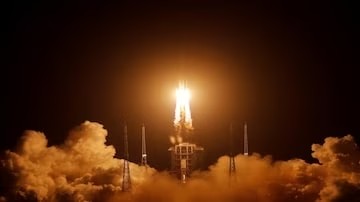China began a 53-day lunar exploration mission on Friday to gather samples from the moon’s far side for the first time and bring them back for analysis. The China National Space Administration (CNSA) stated that the Chang’e-6 mission is the first of its kind in the history of human lunar exploration. It aims to gather and then return samples from the moon’s far side to Earth.
The expedition would take 53 days in all. From Earth, it is impossible to see the moon’s far side. An official declared that the Chang’e-6 launch was “a complete success” one hour after it took place.
A Long March-5 Y8 rocket carrying the lunar probe was launched without incident from the Wenchang Space Launch Site near the southern island state of Hainan in China. State-run television carried live coverage of the launch. CNSA stated that Chang’e 6 is made up of four parts: an orbiter, a lander, an ascender, and a re-entry module.
The samples will be taken by the ascender to the lunar orbiter where they will be transferred to the re-entry module, which will return them to Earth after they have collected dust and rocks on the moon. Prior to now, the CNSA stated that the mission is expected to lead to significant advancements in critical technologies, including automated sample gathering, launch, and ascent from the moon’s far side. The probe will investigate the landing zone scientifically in the interim.
The Chang’e-6 mission’s lander will carry scientific instruments from France, Italy, and the European Space Agency/Sweden, while the orbiter will carry a Pakistani payload. This information was released by the CNSA. For the first time, China’s moon mission includes an orbiter from Pakistan, an all-weather partner.
Pakistan’s Institute of Space Technology (IST) has developed the ICUBE-Q satellite, which carries two optical cameras to image the lunar surface. The Chang’e lunar exploration probe, named after the moon goddess, collected samples from the moon’s near side. China plans to have a lunar station on the moon and has successfully launched unmanned missions to the moon and Mars.

